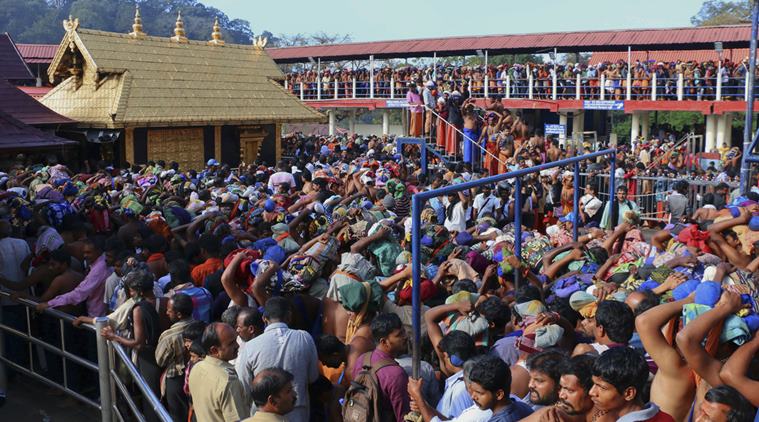Anti-Gandhi at Sabarimala
Protests against women’s entry undo decades of Kerala’s reforms.

The majority verdict of the SC was emphatic when it upheld the supremacy of the Constitution and struck down the so-called tradition of banning women in the age group 10 to 50 from visiting this hilly abode of Lord Ayyappa.
Mahatma Gandhi’s first major political intervention in Kerala took place in the sleepy town of Vaikom, in the then princely state of Travancore. The Vaikom Satyagraha was a crusade to securing rights for lower castes to use public roads around the famous Mahadeva temple. At the forefront of the campaign was Gandhi and the state Congress. Paradoxically, almost a century later, the Mahatma’s ardent disciples are waging a war to protect one of the last fragile bastions of inequality and untouchability in Kerala, where Gandhi once played the catalyst for temple-entry agitations. Worse, the Congress campaign now is to undermine an enlightened verdict of the Supreme Court (SC).
Call it a farce, but prominent political parties like the Congress and the BJP that are meant to uphold constitutional values have joined hands with certain forces that want to maintain the status quo and oppose any effort to redeem the Sabarimala temple, the most important pilgrim centre of Kerala, from the blemish of gender injustice. The majority verdict of the SC was emphatic when it upheld the supremacy of the Constitution and struck down the so-called tradition of banning women in the age group 10 to 50 from visiting this hilly abode of Lord Ayyappa. “The social exclusion based on menstrual status is but a form of untouchability, which is anathema to constitutional values,” said the Court, resonating the slogans that were heard a century ago in Vaikom and later in many other temple towns of Kerala.
There have been numerous analyses of the SC verdict but most don’t offer a historical perspective of temple reforms in the state. The ongoing protests in Kerala emphasise retaining tradition, rituals, rites and customs. The question is: Aren’t these protesters being selective about their demand for upholding tradition? Are they oblivious of the evolution of Sabarimala? Yes. The traditions of Sabarimala that involved non-Brahmin communities are not seen as traditions that need to be protected. There are several Sabarimala traditions that had communities such as Ezhavas and tribals as stakeholders.
Makaravilakku (lighting at Ponnambala medu hill) is a ritual that is part of the tradition. For decades, this ritual was performed by tribals belonging to Malayarayans. Again, a prominent Ezhava family called Chilrappan Chira at Alappuzha used to enjoy exclusive rights to a prominent custom called “vedipazhipadu” (ceremonial fireworks) in Sabarimala. Both these rituals were usurped from the tribals and Ezhavas respectively and none of the protesters has ever talked about the unceremonious end of these traditions. Does it mean that customs involving scheduled tribes and other backward communities are inferior?
Further, this is a temple that allows entry to men of all religious groups, but not Hindu women. A galaxy of scholars of Hinduism and historians favour women’s entry because there are no scriptures that ban it. In other parts of India where temple traditions are centuries older, women have been permitted entry lately.
In Sabarimala, the ban is modern, not traditional. All the leaders of the anti-Court protest feign ignorance about the sequence of events that led to the banning of menstruating women from entering the temple by the Kerala High Court in 1991.
T K A Nair, a well known former civil servant, who served as Manmohan Singh’s principal secretary and advisor got his name — T K Ayyappankutty Nair — because his customary rice-feeding ceremony took place in Sabarimala. His mother attended the ceremony. Various affidavits and documents submitted by the Devaswom Board in the high court underline the fact women of all ages had indeed entered Sabarimala before the 1991 verdict. Even the then 44-year-old Maharani of Travancore had visited the dwelling place of Ayyappa on May 13, 1940. Now it is claimed that Maharani made the visit after a uterus removal surgery. How does this make a difference to the celibacy issue that many protestors are putting across?
A senior Congress leader loudly proclaiming that menstruating women are impure reminds me of Swami Vivekananda’s statement a century ago that Kerala is a lunatic asylum. The mindsets of some people have not changed even close to a century after the Kerala Renaissance championed by Sree Narayana Guru, Ayyankali and others.
Now, let’s not forget that Kerala is what it is primarily on account of its movements that forced fundamental changes. Padmanabha Swamy temple, famous for its treasure, was once beyond the reach of lower castes. And in many temples, even Nair women had to enter without covering their breasts.
Things have changed not because the priestly classes had a revelation and, therefore, became generous, but thanks to the perseverance of our revolutionaries. After the temple entry proclamation was announced in the first half of the last century, Gandhi said, while entering a famous Kerala temple, “Till the other day I was a fighter but this time I have come here as a normal pilgrim”.
Since then, Kerala has further transformed and eliminated burrows of inequality and untouchability. It is a pity that some of Gandhi’s so-called followers want to turn the clock backwards.
The writer is MD of Kairali TV and media advisor to the chief minister of Kerala






































No hay comentarios:
Publicar un comentario